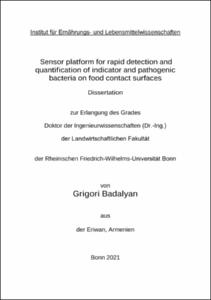Badalyan, Grigori: Sensor platform for rapid detection and quantification of indicator and pathogenic bacteria on food contact surfaces. - Bonn, 2021. - Dissertation, Rheinische Friedrich-Wilhelms-Universität Bonn.
Online-Ausgabe in bonndoc: https://nbn-resolving.org/urn:nbn:de:hbz:5-62871
Online-Ausgabe in bonndoc: https://nbn-resolving.org/urn:nbn:de:hbz:5-62871
@phdthesis{handle:20.500.11811/9256,
urn: https://nbn-resolving.org/urn:nbn:de:hbz:5-62871,
author = {{Grigori Badalyan}},
title = {Sensor platform for rapid detection and quantification of indicator and pathogenic bacteria on food contact surfaces},
school = {Rheinische Friedrich-Wilhelms-Universität Bonn},
year = 2021,
month = aug,
note = {Foodborne pathogenic bacteria represent a global problem for public health. Escherichia coli and Coliforms indicates the possible contamination of food, water and food processing environments. In food processing environment contact surfaces act as harbor for bacteria and can be one of the main sources of contamination and cross contamination of food at different production stages. The lack of early warning system as well as the disadvantageous (e.g. long detection time, sample preparation and different dilution steps for the enumeration) of the existing methods served as a base for conducting this doctoral work. A novel combined colorimetric and voltammetric sensor platform based on screen printed carbon electrode coated by graphene modified polyacrylamide gel (GR/PAAGC) was developed. The developed platform that contains new electrochemical substrates and construction materials was implemented for efficient sampling, sensitive detection and enumeration of Coliforms, E. coli and Staphylococcus aureus on food contact surfaces. The optical signals produced by mentioned products could be detected both visually or spectrophotometrically. The electrochemical peaks of the released products were directly proportional to the concentration of Coliforms, E. coli and St. aureus. Bacterial cell concentration ranging from 1.8 log10CFU/mL to 8 log10CFU/mL were detected. Well-shaped, sharp voltammetric curves were generated within 3 h. Redox peaks exhibited good sensitivity. After series of optimization experiments, Coliforms and E. coli ranging from 0.4 log10CFU/cm2 to 7 log10CFU/cm2 as well as St. aureus ranging from 1.6 log10CFU/cm2 to 6 log10CFU/cm2 on stainless steel surfaces were detected within 30 min. The optimization of optical characteristics of PAA gel system allowed production of rapid visible signals (within 30 min) in case of the presence of target bacteria. The developed GR/PAA-gel carbon sensor platform can be used for rapid (30 min) single detection of Coliform bacteria, as well as for the real-time monitoring of growth of Coliform bacteria on stainless steel surfaces during processing shift.
Beside, rapidity and sensitivity the proposed sensor can be used for detecting and distinguishing the target bacteria both in heavy soiled, contaminated as well as cleaned and disinfected environments.},
url = {https://hdl.handle.net/20.500.11811/9256}
}
urn: https://nbn-resolving.org/urn:nbn:de:hbz:5-62871,
author = {{Grigori Badalyan}},
title = {Sensor platform for rapid detection and quantification of indicator and pathogenic bacteria on food contact surfaces},
school = {Rheinische Friedrich-Wilhelms-Universität Bonn},
year = 2021,
month = aug,
note = {Foodborne pathogenic bacteria represent a global problem for public health. Escherichia coli and Coliforms indicates the possible contamination of food, water and food processing environments. In food processing environment contact surfaces act as harbor for bacteria and can be one of the main sources of contamination and cross contamination of food at different production stages. The lack of early warning system as well as the disadvantageous (e.g. long detection time, sample preparation and different dilution steps for the enumeration) of the existing methods served as a base for conducting this doctoral work. A novel combined colorimetric and voltammetric sensor platform based on screen printed carbon electrode coated by graphene modified polyacrylamide gel (GR/PAAGC) was developed. The developed platform that contains new electrochemical substrates and construction materials was implemented for efficient sampling, sensitive detection and enumeration of Coliforms, E. coli and Staphylococcus aureus on food contact surfaces. The optical signals produced by mentioned products could be detected both visually or spectrophotometrically. The electrochemical peaks of the released products were directly proportional to the concentration of Coliforms, E. coli and St. aureus. Bacterial cell concentration ranging from 1.8 log10CFU/mL to 8 log10CFU/mL were detected. Well-shaped, sharp voltammetric curves were generated within 3 h. Redox peaks exhibited good sensitivity. After series of optimization experiments, Coliforms and E. coli ranging from 0.4 log10CFU/cm2 to 7 log10CFU/cm2 as well as St. aureus ranging from 1.6 log10CFU/cm2 to 6 log10CFU/cm2 on stainless steel surfaces were detected within 30 min. The optimization of optical characteristics of PAA gel system allowed production of rapid visible signals (within 30 min) in case of the presence of target bacteria. The developed GR/PAA-gel carbon sensor platform can be used for rapid (30 min) single detection of Coliform bacteria, as well as for the real-time monitoring of growth of Coliform bacteria on stainless steel surfaces during processing shift.
Beside, rapidity and sensitivity the proposed sensor can be used for detecting and distinguishing the target bacteria both in heavy soiled, contaminated as well as cleaned and disinfected environments.},
url = {https://hdl.handle.net/20.500.11811/9256}
}






